
Researchers at Harvard University in the US have made the first ultra-high-quality micro-ring and racetrack resonators from lithium niobate. The new devices, which consist of plasma-etched subwavelength waveguides that can propagate light across a metre-length path while losing only about half their optical power, have quality factors of up to 107. They might be used to make ultra-efficient integrated photonics circuits, in quantum photonics and optical communications.
Lithium niobate is used in a wide range of optical and microwave technologies thanks to its unique electro-optical properties that allow it to efficiently transform electronic signals into optical ones. Lithium niobate modulators, for example, are the workhorse of modern telecommunications and convert electronic data into optical information in fibre-optic cables.
There is a problem, however, with this material in that it is difficult to make high-quality small-scale devices out of it, which means that on-chip applications are simply not possible.
Plasma etching
A team of researchers led by Marko Loncar has now succeeded in overcoming this problem by fabricating ultra-high-Q lithium niobate micro-ring and racetrack resonators (with ultra-low loss and high optical confinement) for the first time by plasma etching these devices.
Researchers normally make optical microstructures using chemical or mechanical etching techniques. Lithium niobate is inert, however, so it cannot be chemically etched. Mechanical etching is also difficult given the hardness of the material.
Loncar and colleagues used standard Ar+ plasma etching to physically sculpt micro-resonators from lithium niobate films that were 600 nm thick and grown on a 2 micron-thick SiO2 wafer. The researchers had already successfully used this technique on diamond films in the past so knew that it worked for such hard materials. They etched a total of 350 nm of lithium niobate using a bias power of 112 W, leaving behind a 250 nm-thin lithium niobate slab. The integrated waveguide-coupled micro-ring and racetrack resonators they made have a bending radius of 80 microns and various “straight arm” lengths and waveguide widths.
Subwavelength waveguides propagate light across a metre-length path
The team measured the optical Q-factors of its devices using a tuneable telecom external cavity diode laser and found that they have propagation losses of less than 3 dB/m. This means that they can propagate light across a metre-length path while only losing about half their optical power. To compare, previous lithium niobate devices lost more than 99% over the same distance.
This new nanophotonic platform is a viable step forward for lithium niobate, say team members Mian Zhang and Cheng Wang. The fact that it has ultralow losses, high optical confinement and a tight bending radius and could be integrated with microwave electrodes bodes well for electro-optics and nonlinear optical systems. This opens up a wide range of applications, including ultralow-loss quantum photonics, coherent microwave-to-optical conversion and active topological photonics.
Since the lithium niobate device layer sits atop a standard silicon wafer, our platform might thus also be integrated with many existing photonics technologies, they add.
The LN micro-ring and racetrack resonators are detailed in Optica 10.1364/OPTICA.4.001536.



